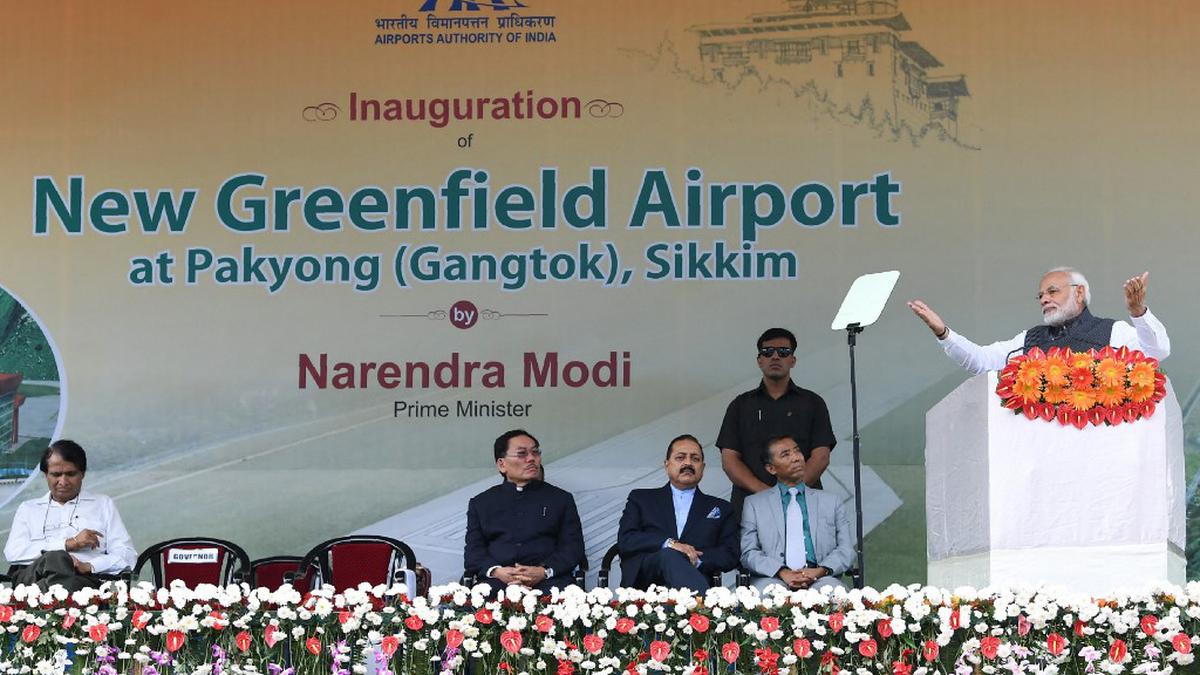Turbulence hits UDAN scheme, 50% routes grounded

The Pakyong airport in Sikkim is among 15 airports that do not see flights any more. Prime Minister Narendra Modi unveiled it in 2018. Photo: PIB via AFP
The government’s biggest claim to success in aviation since 2014 is building “74 airports in seven years”, as opposed to the same number built in the seven decades since Independence. However, only 11 of these airports have actually been built from scratch, while 15 airports have fallen into disuse over this period, due to the collapse of almost half the routes launched under the regional connectivity scheme (RCS).
In the recent past, airport development has primarily been undertaken under the RCS, which was launched in 2017 to improve air connectivity for smaller cities, and to redevelop under-utilised airports. This largely involved the revival of old airstrips that were either lying unused or were used sparsely.
The government launched 479 routes to revive these airports, out of which 225 have since ceased operations, according to the Ministry of Civil Aviation’s response to questions from The Hindu.
Beyond the stats
Only 11 greenfield airports have become operational since May 2014, according to the Minister of State for Civil Aviation V.K. Singh’s reply to a question in the Rajya Sabha on July 24. These include the airports at Mopa in Goa, Shirdi and Sindhudurg in Maharashtra, Kalaburagi and Shivamogga in Karnataka, Kushinagar in Uttar Pradesh, Orvakal (Kurnool) in Andhra Pradesh, Durgapur in West Bengal, Pakyong in Sikkim, Kannur in Kerala, and Donyi Polo in Arunachal Pradesh.
The figure of 74 new airports, regularly trotted out by Prime Minister Narendra Modi as well as Civil Aviation Minister Jyotiraditya Scindia, includes nine heliports and two waterdromes. These two waterdromes, built for seaplanes between Gujarat’s Gandhinagar and the Statue of Unity in Kevadia, closed down soon after the PM’s launch in October 2020, as SpiceJet discontinued its flights after a “change in technical requirements”, the airline told The Hindu in response to a questionnaire.
As many as 15 airports, including Sikkim’s only airport in Pakyong, and those in Punjab’s Adampur, Pathankot, and Ludhiana do not see any flights anymore, according to a senior government official.
Subsidising routes
The RCS, also known as the Ude Desh Ka Aam Nagrik scheme, was launched with the aim of taking flying to the masses by improving air connectivity for tier-2 and tier-3 cities, and subsidising air travel on these routes.
The routes are awarded after a bidding process, and the winning airlines are given certain incentives, along with viability gap funding (or a subsidy) equivalent to 50% of the seating capacity on their aircraft. In return, the airlines sell 50% of their seats at a flat rate of ₹2,500 per hour of flight, in order to make air travel affordable. The cost of the subsidy is borne by Indian airlines flying on non-RCS routes, who pay an RCS levy of ₹15,000 per departure, as per the latest revision that came into effect in April 2023. The airlines further pass the levy on to their passengers on non-RCS flights. A total sum of ₹2,038 crore has been collected as RCS levy.
The scheme also set aside a sum of ₹4,500 crore to revive old airports by recarpeting runways and erecting terminal buildings. Of these, 46 airports have been redeveloped by the Airports Authority of India, and the remaining by State governments and Public Sector Units. The government has so far spent ₹3,490 crore on these airports. The Finance Ministry approved another ₹1,000 crore for this purpose in May this year, for a period of three years.
Commercially unviable
Of the 225 routes that have ceased operations, 128 routes shut down even before completing the mandatory three-year period under the scheme. Airlines found 70 of these routes to be commercially unviable despite the subsidy, while the remaining 58 have been cancelled either due to “non-compliance” by the airline operator, or the airline surrendering routes, or the airline companies shutting down, as in the case of Air Deccan and Air Odisha.
As many as 97 routes shut down after completing the three-year period during which the government provides support. The objective of the scheme was that after the three-year period, airlines would be able to sustain operations on their own without government support, but out of the 155 routes that have completed three years, only 58 have survived.
SpiceJet, which bagged 74 routes — or every one in five routes awarded to airlines under the scheme — now flies on only 20 of them, forcing the AAI to send it multiple show-cause notices, warning that its security deposit would be forfeited.
The airline said it could not operate 12 routes as airports such as Thanjavur, Moradabad, Saharanpur and Ayodhya were not ready for operations. For the remaining routes, the airline said that it “tried hard to establish these markets, but passenger demand remained very low.”
For all the latest business News Click Here

